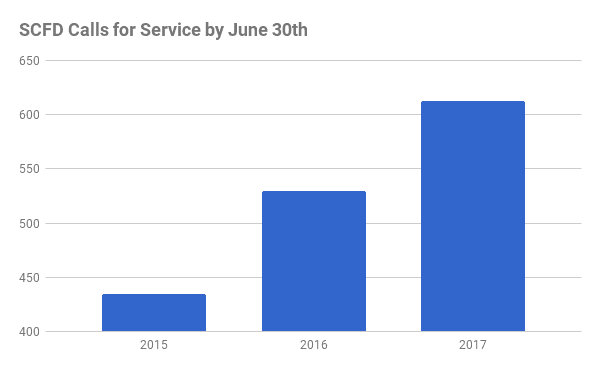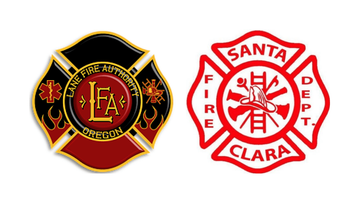Our Intergovernmental Agreement with Lane Fire Authority
Santa Clara Fire District (SCFD) and Lane Fire Authority (LFA) have signed an Intergovernmental Agreement (IGA) that will take effect on July 1, 2018. The purpose of this page is to provide the public with information relating to our agreement, as well as explain how this agreement impacts SCFD and LFA residents.
An IGA is not the same as a merger. Under a merger, all aspects of the two districts are merged together. This results in changes to tax rates and elected official positions. An IGA merges the operations but not the finances of the organizations. This means that both districts would maintain their own budgets, tax rates, and elected officials. However, resources would be pooled in order to increase operational efficiency.
What is an Intergovernmental Agreement?
An Intergovernmental Agreement (IGA) is an agreement between two public entities to provide services together. In the case of SCFD and LFA, this agreement would pertain to all fire district services. IGAs do not raise taxes for residents and both districts maintain ownership over their own assets. The resources of each district, while separately owned, are used together in order to increase operational efficiency and improve the level of service provided to the public.
An IGA sometimes leads to a full merger. However, Lane Fire Authority Chief Terry Ney and Santa Clara Fire Chief Randy Wood do not see a full merger as a legitimate option at this point in time because of the difference between LFA and SCFD's permanent tax rates.
Have Fire Service IGAs been successful in Lane County?
Many fire protection agencies in Lane County have recently entered into IGAs or mergers in order to provide a higher quality of service to the residents of their jurisdictions. Recent successful examples include:
- Lane Rural Fire/Rescue and Lane County Fire District #1
- Eugene and Springfield Fire Departments
- Goshen and Pleasant Hill Fire Districts
These fire service providers increased their level of service through IGAs without raising taxes.
Why do SCFD and LFA need an IGA?
Both SCFD and LFA are receiving more calls per year, but they are getting less help from volunteer staff. Nationwide, calls for service are increasing and the number of volunteers is decreasing. Santa Clara and LFA are no exceptions.
By combining personnel, SCFD and LFA could establish a fire engine that is staffed 24 hours a day, 7 days a week. This engine would be based out of LFA Station 115 and respond to calls in the Santa Clara area, in addition to the area that Station 115 already covers.
An IGA is not the only option for addressing these issues. It does, however, have the advantage of not requiring an increase in taxes. Other options, like hiring more staff or contracting with the City of Eugene, would require higher taxes.

This chart shows the number of calls SCFD responded to in the first half of the year for 2015, 2016, and 2017. Mid-year calls are up by over 40% compared to 2015.

Can SCFD and LFA work well together?
SCFD and LFA have a long history of successful collaboration. The two districts own and operate a training facility together, and put their recruit firefighters through a joint fire academy. LFA and SCFD already respond to many of each other's calls through mutual and automatic aid agreements. The two districts also share a weekend duty officer.
Effects of the IGA
Effect on Taxes:
The IGA does not raise taxes. The tax rates for SCFD and LFA remain separate and the same as they would have been without the IGA.
24/7 Engine Company:
The goal of the IGA is to establish a 24/7 engine company based out of LFA Station 115. The Engine will respond to calls in the Santa Clara area, as well as the North Battalion area of Lane Fire Authority.
Response Area Line:
The city limits are currently similar to a patchwork quilt in the Santa Clara area due to annexations of unincorporated county land by the City of Eugene. Once annexed, those properties receive fire protection service from Eugene Springfield Fire & EMS. As a result, one address might be served by the City of Eugene, and their neighbors might be in SCFD. After establishing a 24/7 engine company, LFA/SCFD will try to establish an agreement with Eugene-Springfield about which areas would receive an LFA/SCFD response, and which areas would receive a Eugene-Springfield response. This response area line would not be based on whether addresses are city or county, but which areas make geographical sense to be served by each agency.
Intermixing SCFD and LFA Volunteers:
Current SCFD volunteers would have the opportunity to work in Lane Fire Authority stations, and vice versa. This would allow volunteers to get a broader range of experiences working in different areas that respond to different types of calls.
Retention of Assets and Reserve Funds:
Both fire districts retain full ownership and control over their stations, apparatus, equipment, reserve funds, and other assets. They collect and levy taxes separately, maintain individual Boards, and have the authority to terminate the IGA if they decide to do so.
